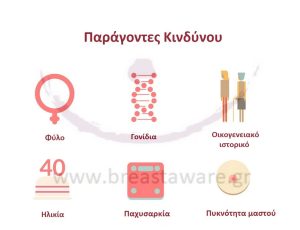Risk Factors for Breast Cancer
Breast cancer is the most common malignancy in women worldwide. Although the exact cause of its occurrence remains unclear, we know that some risk factors significantly increase the likelihood of disease.
It is important to emphasize that the presence of these factors does not necessarily mean that a woman will develop cancer, but it helps identify those who may benefit from prevention, early diagnosis or personalized monitoring.

Detailed List of Documented Risk Factors:
- Sex
Breast cancer occurs predominantly in women — about 100 times more frequently than in men.
- Age
The risk increases with age. While a 20-year-old woman has a 0.06% chance of developing cancer in a decade, that chance rises to 3.84% at 70 years. After 75-80, the risk gradually decreases.
- Breast Density
Women with dense mass tissue (mammographically) have up to 5 times higher risk occurrence of malignancy compared to those with less dense tissue.
- Ethnicity
In the USA, the white women has the highest rates of breast cancer, although black women more often develop more aggressive types.
- Hormonal Factors
- Early menarche (before age 12) or late menopause (after 55) increase risk due to prolonged estrogen exposure.
- The Childlessness or first pregnancy after 30 is associated with increased risk.
- The breastfeeding reduces risk: for every 12 months of breastfeeding, relative risk decreases by about 4,3%.
- Benign Breast Lesions
Benign tumors with atypical cells on biopsy carry a higher risk of future malignancy.
- Personal and Family History
- Women who have already had the disease have annual risk ~1% for cancer in the other breast.
- If there is 1st degree relative (mother, sister, daughter) with a history, the risk is doubled or is tripled if there is more than one relative.
- Genetic Mutations
Approximately 5-10% of breast cancer cases are linked to mutations in genes such as:
- BRCA1 and BRCA2 (40-70% lifetime risk)
- TP53, PTEN, ATM, CHEK2
- Hormonal Medications
- The hormone therapy in menopause, especially when it contains estrogen and progestin, increases the risk.
- The Long-term use of contraceptives has a milder but still significant effect, which diminishes 10 years after stopping them.
- Radiation Exposure
The Therapeutic radiation to the chest (e.g. for Hodgkin lymphoma) at a young age increases the risk, especially if the exposure occurred before age 30.
- Lifestyle
- Alcohol consumption: Every 10g/day (1 drink) increases risk by 7-10%.
- Smoking and and night shift work are also associated with higher risk.
- On the contrary, proper diet, regular exercise and healthy weight reduce the likelihood of disease.
- Obesity and Height
- The Postmenopausal obesity significantly raises risk due to estrogen production in adipose tissue.
- Interestingly, taller women have a slightly increased risk, though the reasons are not fully understood.
Conclusion
The knowledge of risk factors for breast cancer is the first step towards prevention and early diagnosis. Although we cannot control all factors, the education and the specialized prevention strategies make a difference.
At breastaware.gr, you will find reliable, scientifically grounded information and practical prevention guides, empowering you to care for yourself responsibly and consciously.
Sources:: WHO, American Cancer Society, Breast Cancer Now, National Cancer Institute, Lancet Oncology, JAMA, NEJM, Nature Reviews Cancer.
